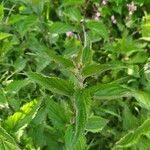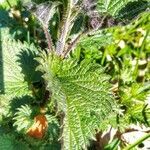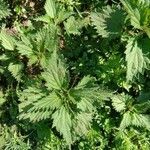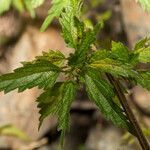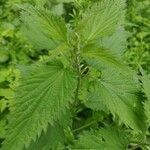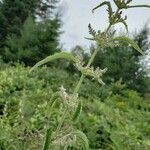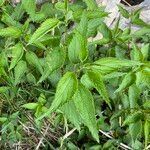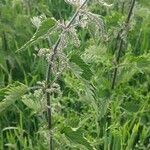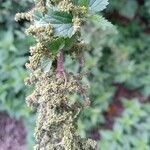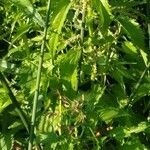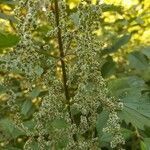Erect perennial herb up to 1 m high, growing from horizontal, ± woody rhizome, dioecious. Stems almost always with dense stinging hairs; stiff hairs present or absent. Leaves lanceolate, (20-)50-150 x (12-)25-90 mm, apical tooth shorter to longer than broad, margin with 11-25 pairs of teeth, with stinging hairs scattered on upper surface or absent, and on veins below, with stiff hairs densely scattered below; petiole (5-)10-40 mm long, with dense stinging hairs, with or without stiff hairs; stipules oblong to broadly lanceolate, 2-6 x 1-3 mm, acute to nearly obtuse, membranous, with up to 5 parallel veins. Inflorescence lax, drooping, with cymose clusters of subsessile flowers, up to 90 mm long; peduncle up to 15 mm long. Female flowers with hairs as in key, 1.0-1.5 mm long; pedicel with stinging and stiff hairs. Male flowers with stiff hairs, 1.25-1.5 mm in diameter. Achenes ovoid, laterally compressed to lenticular, with a raised central area on each face, smooth or minutely punctate, pale ochre.
Erect, rhizomatous perennial, usually simple, to 2 m; lvs serrate, acute or acuminate, 5–15 cm; stipules lance-linear, 5–15 mm; infls branched, many-fld, commonly exceeding the subtending petioles; fruiting cal 2 mm, pubescent; achene ovate, 1.5 mm. Nearly cosmopolitan, either as a native or an intr. sp., and highly variable. June–Sept. Var. dioica, native to Europe but well established in our range, is dioecious, weak-stemmed, and rather densely hairy, with mostly broadly ovate, cordate-based lvs with stinging hairs on both sides, and with the teeth commonly 5–6 mm deep; 2n=52. Var. procera (Muhl.) Wedd., the native phase, is usually monoecious, stouter and more sparsely hairy, with ovate to lance-oblong lvs that are seldom cordate at the base, with the stinging hairs commonly confined to the lower surface, and with the teeth averaging 2–3.5 mm deep; 2n=26 in ours. (U. gracilis; U. viridis)
Usually dioecious, perennial herb to 1.5 m high; stems and leaves distinctly pubescent between the longer, scattered stinging hairs. Leaves: lamina lanceolate to broadly ovate, broadly toothed to incised, acute to caudate apex, cordate to truncate at base, mostly 3–12 cm long, 1–7 cm wide, both surfaces dark green; lateral veins 3–5 pairs, the second pair prominent, extending c. half of lamina length; petiole 2.5–6 cm long, usually less than half of the lamina length; stipules c. 5–10 mm long. Inflorescences often paired, paniculate, unisexual, usually longer than petiole. Flowers shortly pedicellate, c. 1–1.5 mm long, c. 1 mm wide, pubescent. Male flowers: pistillode small. Female flowers: ovary ovoid. Achenes ovoid to compressed-ovoid, faintly keeled, smooth, c. 1–1.5 mm long.
Herbs , perennial, rhizomatous, 5-30 dm. Stems simple or branched, erect or sprawling. Leaf blades elliptic, lanceolate, or narrowly to broadly ovate, 6-20 × 2-13 cm, base rounded to cordate, margins coarsely serrate, sometimes doubly serrate, apex acute or acuminate; cystoliths rounded. Inflorescences paniculate, pedunculate, elongate. Flowers unisexual, staminate and pistillate on same or different plants, staminate ascending, the pistillate lax or recurved. Pistillate flowers: outer tepals linear to narrowly spatulate or lanceolate, 0.8-1.2 mm, inner tepals ovate to broadly ovate, 1.4-1.8 × 1.1-1.3 mm. Achenes ovoid to broadly ovoid, 1-1.3(-1.4) × 0.7-0.9 mm.
Perennial herb, 0.3-1.0 m high; dioecious. Leaves opposite, lanceolate, margins dentate or serrate with stinging hairs above, on veins below, (3-)5-7-nerved; petioles up to 40 mm long; stipules oblong to broadly lanceolate, 6 x 3 mm. Inflorescences in lax, axillary, paniculate clusters, up to 90 mm long; peduncle ± 15 mm long. Flowers bisexual or functionally unisexual, minute, often ebracteate. Male flowers: tepals 4, with stinging hairs; ± 1.5 mm in diam. Female flowers: tepals 4, pubescent; stigma penicillate-capitate, up to 1.5 mm long. Flowering time Oct.-Mar. Fruit a sessile, laterally compressed achene, ovate or oblong in outline, pale ochre.
Rhizomatous, erect perennial, usually dioecious, rarely with a few fls of the other sex, moderately clothed in short-stalked stinging hairs, otherwise sparsely to densely hairy. Stems with few if any lateral branches, up to 1.5 m high. Lvs broadly lanceolate or ovate, acute to acuminate, usually cordate at base, occasionally truncate, coarsely serrate, (5)-6-20-(25) cm long. Petiole up to ⅔ as long as lamina. Stipules 4 per node, entire, 4-20 mm long. Racemes unisexual, up to 9 cm long. Perianth segments of ♀ fls very unequal, hairy; margins glabrous. Achene ellipsoid, light brown, c. 1.5 mm long.
A herb that continues to grow year after year. It can be 1-2 m high. The leaves have stalks. They are opposite. The leaves are 4-15 cm long by 1-7 cm wide. They have a leaf like structure at the base of the leaf stalk. The leaves are pointed. The flowers are white or yellow. They have male and female flowers on separate plants. The plant has stinging hairs on the leaves and stems.
Dioecious perennial herb, up to 1 m tall, with a ± woody rhizome, usually with dense stinging hairs on stems and leaves. Leaves petiolate, lanceolate, truncate to ± cordate at base, margin toothed. Flowers in lax, slender, drooping, cymose clusters, small, whitish, tepals of females hairy on backs. Achenes ovoid, pale ochre.

